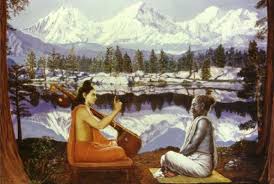

reviews [0] Being a Human - Karma & Dharma [13]
The Lord created the universe, and wishing to secure order therein, He first created the Prajapatis (Lords of creatures) such as Marichi and caused them to adopt the Pravritti Dharma, the Religion of Works. He then created others such as Sanaka and Sanandana, and caused them to adopt Nivritti Dharma, the Religion of Renunciation, characterised by knowledge and indifference to worldly objects. It is the twofold Vedic Religion of Works and Renunciation that maintains order in the universe. This Religion which directly leads to liberation and worldly prosperity has long been practised by all castes and religious orders (varna ashramas) - from the Brahmins downwards- who sought welfare.
The Purpose of the Divine Incarnation
When, owing to the ascendancy of lust in its votaries, religion was overpowered by irreligion caused by the vanishing faculty of discrimination, and irreligion was advancing,- it was then that the original Creator (Adi-karta), Vishnu, known as Narayana, wishing to maintain order in the universe, incarnated Himself as Krishna, begotten in Devaki, by Vasudeva, for the preservation of the ‘earthly Brahman’ (the Vedas, the Brahmins and Yagnas or sacrifices), of spiritual life (Brahmanatva) on earth. For it was by the preservation of spiritual life that the Vedic Religion could be preserved, since thereon depend all distinctions of caste and religious order. [Note: Kshatriyas and others require the help of the Brahmins, the spiritual class, in the performance of sacred rites and in the study of scriptures.]
The Lord, always possessed as He is of (infinite) knowledge, supremacy, power, strength, might and vigour, controls Maya- belonging to Him as Vishnu- the Mula prakriti, the First Cause, composed of three Gunas or energies (qualities known as Sattva,Rajas and Tamas), and He appears to the world as though He is born and embodied and helping the world at large; whereas really He is unborn and indestructible, is the Lord of creatures, and is by nature Eternal, Pure, Intelligent and Free.
Without any interest of His own, but with the sole intention of helping His creatures, He taught to Arjuna, who was deeply plunged in the ocean of grief and delusion, the twofold Vedic Religion, evidently thinking that the Religion would widely spread when accepted and practised by men of high character.
The Gita and the Commentary
It is this religion, which was taught by the Lord, that the omniscient and adorable Veda-Vyasa (the arranger of the Vedas) embodied in the seven hundred verses called Gita.
This famous Gita-Sastra is an epitome of the essentials of the whole Vedic teaching; and it’s meaning is very difficult to understand. Though, to afford a clear view of its teaching, it has been explained word by word and sentence by sentence, and its import critically examined by several commentators, still I have found that to the laity it appears to teach diverse and quite contradictory doctrines. I propose, therefore, to write a brief commentary with a view to determine its precise meaning.
Jnana-Yoga (Yoga of knowledge) is the means to the Supreme Bliss
The aim of this famous Gita-Sastra is, briefly, the Supreme Bliss. A complete cessation of samsara or transmigratory life and of its cause. This accrues from that Religion (Dharma) which consists in a steady devotion to the knowledge of the Self, preceded by the renunciation of all works. So with reference to this Religion, the doctrine of the Gita, the Lord says in the Anu-Gita as follows. [Note: Anu-Gita forms part of the Asvamedha Parva, Mahabharata, setting forth a sort of recapitulation of the teachings of the Bhagavad Gita.]
"That religion, indeed, is quite sufficient for the realisation of the state of Brahman, the Absolute."
"He is without merit and without sin, without weal and woe,-he who is absorbed in the One Seat, silent and thinking nothing."
-Asvamedha Parva XVI 12
And He also says:
"Knowledge is characterised by renunciation."
-Asvamedha Parva, XLIII, 26
"Abandoning all Dharmas, come to Me alone for shelter."
-Asvamedha Parva, XVIII, 66
How Karma-Yoga is a means to the Supreme Bliss
Though the Religion of Works, which, as a means of attaining worldly prosperity, is enjoined on the several castes and religious orders, leads the devotee to the religion of the Devas and the like, when practised in a spirit of complete devotion to the Lord and without regard to the (immediate) results, it conduces to the purity of the mind (sattva-suddhi). The man whose mind is pure is competent to tread the path of knowledge, and to him comes knowledge; and thus (indirectly) the religion of Works forms also a means to the Supreme Bliss. Accordingly, with this very idea in mind, the Lord says:
"He who does actions, placing them in Brahman" (the Supreme Reality)
……… "Yogis perform actions, without attachment, for the purification of the self."
-Gita, ch. 5, verses 10 & 11
The specific subject and object of the Gita-Sastra
The Gita-Sastra expounds this twofold Religion, whose aim is the Supreme Bliss. It expounds specially the nature of the Supreme Being and Reality as Vasudeva, the Parabrahman, who forms the subject of the discourse. Thus the Gita-Sastra treats of a specific subject with a specific object and bears a specific relation (to the subject and object). A knowledge of its teaching leads to the realisation of all human aspirations. Hence my attempt to explain it.











